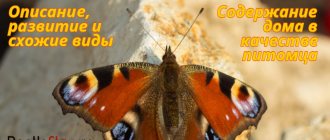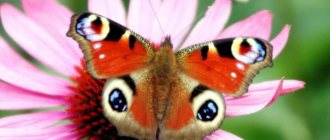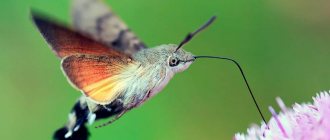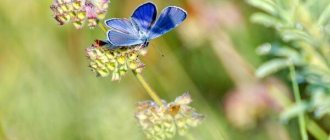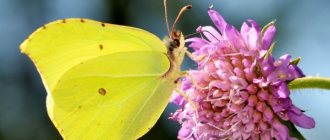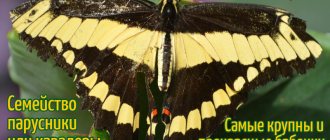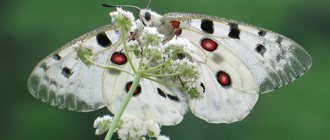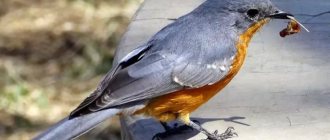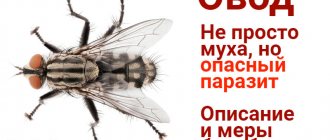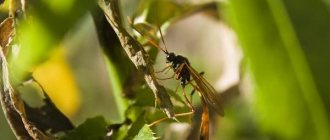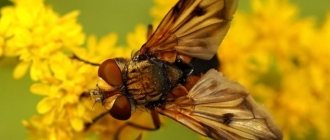- Wild animals
- >>
- Insects
The peacock butterfly has a very beautiful pattern on its wings, which is why it is sometimes even kept at home. She is unpretentious and tolerates captivity well if the conditions are suitable. In nature, it can be seen in almost any warm month, but they are much less common than urticaria or cabbage, especially in cities.
Origin of the species and description
Photo: Peacock butterfly
Lepidoptera appeared a very long time ago: in the early Jurassic period, almost two hundred million years BC. Gradually they developed, more and more species appeared, and they actively spread across the planet along with the spread of flowering plants across it.
During evolution, the formation of a proboscis occurred, they began to live more time in the form of an imago, and more and more species with large and beautiful wings appeared. The final formation of many modern species is attributed to the Neogene - at the same time the peacock eye appeared.
Video: Peacock butterfly
It is, along with approximately 6,000 other species, part of the large family of nymphalids. It looks similar to urticaria, which is not surprising, because they are in the same genus. His wings are the same black and orange tone, and stand out only with a brighter and more beautiful pattern.
The description was first made by Calus Linnaeus in 1759. Then it received the specific name Papilio io. Then it was replaced first by Inachis io - this name was taken from the mythology of Ancient Greece, and combined the name of King Inach and his daughter Io.
But ultimately, this symbolic combination had to be replaced with Aglais io in order to correctly determine the place of the species in the classification. There is also a night peacock eye, but this species is not closely related: it belongs to a different genus and even family.
Popular message topics
- Volcanoes of Kamchatka
Kamchatka is a peninsula in eastern Russia on which a large number of volcanoes are located, which are part of the Pacific Rim. The exact number of volcanoes is unknown; information varies from source to source. - Japan
Japan is a group of 6,800 islands (the Japanese Archipelago) located in eastern Asia. Despite its relatively small size (377,000 km²), this country ranks 10th in the world in terms of population. - The work of Oleg Efremov
Speaking about Ivan Antonovich Efremov, it should be said that this man had absolutely encyclopedic knowledge and from this point of view he was the successor of that series of outstanding
Appearance and features
Photo: Night peacock butterfly
It is not difficult to distinguish butterflies from other butterflies; this can be done by the pattern on the wings - on each of them in the corner there is a yellow circle, inside of which there is another blue one. It really does look like an eye. The main color of the wing looks like hives; a rich orange tone predominates.
But the opposite side of the wings looks completely different: it is dark gray, almost black. This coloration makes the butterfly fly like a dry leaf and allows it to remain almost invisible to predators on tree trunks when it hibernates or simply rests and closes its wings.
Their span is larger than average - about 60-65 mm. They have a jagged outer edge with a light brown stripe running along it. The body is plump, like other types of urticaria, and has a developed oral apparatus with a proboscis.
The butterfly has compound eyes of a complex structure. There are six legs, but only four are used for walking, and the front pair is poorly developed. Sexual dimorphism is pronounced: females are much larger than males.
Interesting fact: The brightness of the butterfly's color is determined by how warm the weather was during pupation and development of the pupa. If it was cool, the wings will appear paler, and in very warm weather the shade will become especially saturated.
Now you know the difference between a daytime peacock butterfly and a night one. Let's see what the bright daytime butterfly eats and where it lives.
Where does the peacock butterfly live?
Photo: Day peacock butterfly
Over large areas, including almost all of Europe and most of Asia. These butterflies prefer temperate and subtropical climates, so they are easy to find in Russia, as well as in the rest of Eurasia, except for the tropical south and deserts, as well as the tundra.
Their concentration is especially high in Germany, and in Central Europe in general. They also live on many islands located around Eurasia, for example, in Japan. But not at all: for example, the peacock’s eye did not reach Crete. For some reason, these butterflies are not found in North Africa, despite the climate suitable for them.
Most often they can be found in forest clearings and garden plots - they love areas close to forests, but at the same time well lit by the sun and rich in flowers. They rarely fly into the thick of the forest because there is not enough sun there, and there is a risk of damaging the leaves by flying through too dense vegetation.
They can also live in moderately mountainous areas up to an altitude of 2,500 meters; they are no longer found higher. They love forest parks, and even more so city parks; they are found in gardens, clearings, as well as along the banks of lakes and rivers - in short, while walking in nature you can meet this butterfly even in the city. But their numbers are clearly orders of magnitude lower in comparison with the same urticaria.
Often the peacock eye migrates over long distances in order to find a more suitable habitat: they can fly tens and even hundreds of kilometers, although this takes them a lot of time - the butterfly cannot overcome a long distance at once, it needs to replenish its strength with nectar and rest, basking in the sun.
Interesting Facts
- Butterflies do not have a sleep period; they are constantly active.
- Butterflies existed a thousand years ago, as their images can be found on Egyptian frescoes.
- The butterfly's eyes consist of 6,000 small lenses.
- Butterflies have taste buds on their legs. When they sit on a leaf, they can taste it.
- Butterflies need sunlight to fly.
- Butterflies take second place after bees in pollinating plants.
- The largest butterfly is considered to be the Atlas peacock-eye. It is often confused with a bird, as its wingspan is more than 30 centimeters.
- During a short life span, the female is capable of laying more than 1000 eggs.
Each butterfly is beautiful in its own way and can please the eye. We must not forget about the value of the environment and try to protect nature.
What does the peacock butterfly eat?
Photo: Peacock butterfly
Nectar from numerous plants.
Among them:
- sivets;
- elder;
- dandelion;
- thyme;
- thistle;
- marigold;
- felt burdock;
- clover;
- marjoram;
- and many others.
Most of all he loves buddleia. Nectar is the main and almost the only source of vitality for an adult butterfly, but in addition to it, the peacock’s eye is also attracted to tree sap - that’s why they can often be seen on trees drinking it.
Another drink they love is the juice of fermented fruits; it is often fed to butterflies in captivity, because it is relatively easy to obtain. To feed the butterfly, you can dilute honey or sugar in water - sometimes small pieces of fruit are also added to this solution. A butterfly in captivity needs to be fed daily.
For caterpillars, food plants are:
- nettle;
- hop;
- raspberries;
- willow;
- broom;
- hemp.
Interesting fact: A butterfly can overwinter in a warm room, but in this case its life processes will not slow down sufficiently and will be too active. As a result, she will either come out of hibernation already old and will fly for only a short time, or even die during hibernation.
Therefore, if there is a butterfly in your apartment in winter, you should carefully take it out and place it in a secluded place, for example, in the attic. Then her hibernation will go well.
Life cycle
The life of a peacock eye consists of several cycles:
- Egg.
- Caterpillar.
- Doll.
- Butterfly.
The peacock eye is a migratory insect species that travels long distances. It flutters above the ground exclusively during daylight hours. With the onset of cold weather, it flies to places with more humid and cooler climatic conditions. The moth settles in forest bark or steppe litter.
A butterfly of this species settles down to spend the winter in a secluded, cool place, where it will be comfortable in its pupal state. If she chooses to spend the winter in a warm room, then she will have little chance of surviving the cold. A warmer temperature than it needs provokes an accelerated metabolism, which results in rapid aging.
Features of character and lifestyle
Photo: Daytime peacock butterfly
The adult form appears at the beginning of summer and enjoys life until September - more precisely, until the autumn cold arrives. These butterflies spend a significant part of their lives in flight, and it can be either active or passive - thanks to their wide wings, they save energy by simply gliding.
They are active only in the light of the sun - as soon as it starts to get cold in the evening, they look for a place to spend the night. They love sunlight and warmth very much, because they require a lot of energy to fly, so they can bask in the sun for a long time before starting their next flight.
They also need good weather to fly. Therefore, if rainy and cold periods in the summer drag on, the peacock’s eye enters diapause - the butterfly falls into a short summer hibernation. She usually spends up to a week in it and returns to active life immediately after it becomes warm and sunny again.
The peacock's eye is a real long-liver; in total, not counting periods of hibernation, it can live up to a year. After the onset of cold weather, it goes to wintering. It is noteworthy that in particularly warm areas, a peacock’s eye can overwinter a second time and wake up from hibernation again in the spring.
Thus, this butterfly can be found in the subtropics throughout most of the year - from March to October. Of course, in temperate latitudes this is much less likely; in the spring, only butterflies accidentally awakened by a thaw can be found, and they fly for only a short time.
Alas, death will probably await them, because a butterfly that wakes up ahead of time spends a lot of energy and cannot replenish it in the required amount - although sometimes it manages to find shelter and continue wintering in order to wake up again when it becomes really warm.
To overwinter, she needs to find a place where it will not be as cold as in the open air, but not warm either: she can climb under the bark of trees, deep into the forest floor, into balconies and attics. The main thing is that this place is protected from the cold and predators.
During hibernation, the butterfly can withstand freezing temperatures, although their exposure is undesirable. But she will not be able to react to the attack, nor will she be able to replenish her reserves of nutrients - so she needs to choose a secluded place and stock up on them in advance.
Notes
- ↑ 1 2 (undefined). Retrieved January 24, 2013. February 2, 2013.
- ↑ 1 2 3 4 5 6 Striganova B. R., Zakharov A. A. Five-language dictionary of animal names: Insects (Latin-Russian-English-German-French) / . - M.: RUSSO, 2000. - P. 270. - 1060 copies. — ISBN 5-88721-162-8.
- ↑ Korshunov Yu. P. Keys to the flora and fauna of Russia // Mace lepidoptera of Northern Asia. Issue 4. - M.: Partnership of Scientific Publications KMK, 2002. - P. 57. - ISBN 5-87317-115-7.
- ↑ 1 2 3 4 Lampeter K. Atlas of butterflies and caterpillars. Habitats. Physical characteristics. Behavior. Reproduction/K. Lampert, Ed. A. I. Bykhovets. Mn.: Harvest, 2003. 736 p.
Social structure and reproduction
Photo: Pair of peacock butterflies
These butterflies live alone. When the breeding season begins, the males divide the territory among themselves, after which each one waits for the female to appear. When this happens, he begins a mating ritual, which includes flying together with mating dances. Butterflies also spread pheromones around themselves, which make it easier for them to find each other.
As a result, the female is fertilized and lays a hundred or several hundred eggs, almost always on a nettle. They take a week or two before the caterpillars emerge - faster in warm weather and longer in cold weather.
These insects are characterized by complete transformation. The first generation caterpillars appear in May, and the second in mid-summer. At first they remain in the brood, and when they grow up, they crawl away from each other and begin to live separately.
The caterpillars are dark in color and covered with long spines, although in reality they offer little protection from predators, but are designed to at least scare away some of them. The caterpillar really looks quite unapproachable, but predators are already accustomed to this species, although it can really have an effect on young and not particularly hungry ones.
In total, the peacock eye lives in the form of a caterpillar for about a month, and its main activity during this time is feeding. She chews the leaf almost continuously, and grows 20 times, her weight increasing even more. Then it pupates and spends 10-20 days in this form, depending on the weather - as in the case of the transformation from egg to larva, the warmer it is, the faster it passes this form.
The pupa can be attached to tree trunks, fences, walls; depending on the color of their surface, its color can also vary, mimicking its surroundings - it can be from light green to dark brown. The pupa, like the caterpillar, has spines.
When development ends, finally breaking the cocoon, the crown of the butterfly's development, the imago, its adult form, appears. She will need very little time to get used to the wings, after which she will be completely ready to fly.
How to determine the lifespan of winged beauties
How long do “flying flowers” live? The life cycle consists of all phases of insect development:
- egg,
- caterpillar,
- doll,
- adult, imago.
When determining the life span of a butterfly, scientists take into account the duration of each stage. Therefore, the time frame is much longer than several days. It is not surprising: the future butterfly spends most of its existence in some stages.
When determining the duration of the life cycle of the Vanessa species, it is taken into account that the insect spends 4 days in the egg phase, and up to a decade in the caterpillar stage, depending on the amount of accumulated fat for transformation into a moth. In the form of a pupa, the future butterfly will live for about a week, and then - apotheosis, transformation into the ideal of grace and beauty.
However, the adult will remain charmed with light wings for about two weeks, no more. And during this period she must have time to lay eggs. Probably for this reason, nature allowed female butterflies to live several days longer than males.
Life cycle components
The lifespan of a moth depends on many factors. The duration is affected by:
- climatic conditions,
- species affiliation,
- coloring
The lifespan of butterflies largely depends on the climate. Most of the species live in tropical and subtropical conditions: capricious beauties love warmth and light. But geographic latitude directly determines the lifespan of an insect.
How long will the insect live? Inhabitants of northern latitudes can live up to two years. In fairly harsh conditions there is little food, the larva does not have time to accumulate useful substances to move to the next stage. The pupa will not be able to become a butterfly next spring. Thanks to “preservation”, the life of the future winged beauty is extended by a whole year!
Affect the lifespan of butterflies and insect migrations. During the year, beautiful creatures make 2 flights, from late spring to early autumn. During this time, 2 generations of adults will change. The pupae will “open” at the end of summer or early spring.
Northern butterflies are stronger than southern ones!
The species to which the moth belongs also plays a significant role. How long does an insect live? Some species live no more than a few hours. And the period is calculated from the laying of eggs until the transformation into an adult. It is wrong to believe that all butterflies can live for several hours or days: on average, they delight people with their beauty for several weeks. True, there are also long-livers.
These include the inhabitants of northern latitudes. Insects have an amazing feature. They fall into suspended animation. In this state, metabolic processes slow down and energy is not spent on maintaining life. Butterflies are resistant even to the treatment of plants with pesticides at this time!
Long-lived among the “flying flowers”
The record holders among winged beauties are insects of the Monarch species. Adults can live up to a year, setting a real record among lepidoptera.
Cabbage plants flutter through the air for about a month. Some of the lemongrass specimens manage to live for several years, even withstanding temperatures below 20 degrees below zero! And blueberry butterflies enjoy life for several days. They were given the shortest possible sentence.
At home, the winged beauty will live longer than in nature. But how much effort will have to be made for this!
Temperature and wintering time also affect the butterfly's lifespan. Severe cold can destroy delicate creatures, and in the warmth of a human home or during a thaw, a moth released from a state of suspended animation can die from exhaustion.
Victims of beauty?
It is known that during its life the graceful beauty goes through several stages, turning from a larva into a caterpillar; a butterfly is the final phase of development. If the insect has not had time to accumulate nutrients for the next stage, it lives longer. The lifetime increases to several years!
Due to the variety of colors, the wonderful “flying flowers” have no rivals in the world of insects. There are amazing specimens. Among them are a transparent butterfly, recognized as a real miracle of nature, and tropical beauties shimmering with all the colors of the rainbow, among which there are real giants with a wingspan of up to 28 cm.
But it is the coloring that causes the shortening of the lifespan: collectors are willing to pay a lot of money to decorate their collections with the desired specimens.
Natural enemies of peacock butterflies
Photo: Peacock butterfly
Butterflies have many enemies in all forms - they are in danger at any stage of life. Adult butterflies suffer less than others, but even they often die in the claws or beaks of predators.
They are hunted by:
- rodents;
- birds;
- large insects;
- reptiles.
It was to protect against these enemies that the peacock’s eye acquired such a bright color. It would seem that she does not help with this at all, on the contrary, she gives out a butterfly! In fact, when her wings are open, she is always alert and ready to fly away from a predator, but when she is resting, she closes them and merges with the bark of the trees.
If the predator nevertheless noticed her and attacked, she sharply opens her wings, and for a moment disorients him due to the sharp change in color - this brief moment is sometimes enough for salvation. Most often, butterflies die because of birds, which are much faster and capable of grabbing them even in flight. It is more difficult for other predators to do this, so all that remains is to lie in wait for them.
Caterpillars are hunted by the same predators as adults, and even more actively - caterpillars are more nutritious, and are also much less mobile, and certainly cannot fly away. Therefore, a significant number of them are exterminated - it is already a great success to survive to the cocoon, and even more so to the imago, since the pupa is even more defenseless.
As in the case of adults, caterpillars suffer most from birds, which love to fly into their clusters and eat dozens of them at once. But reptiles and rodents are not far behind: it is difficult for them to catch an adult butterfly, but a larva is a completely different matter. They are even threatened by ants, who, through coordinated actions, can kill a caterpillar that is much larger than them.
They still have ways to protect themselves from enemies: they can take a threatening pose, as if they are going to attack themselves, they begin to crawl in all directions, if they still live together - so at least part of them will survive, curl up into a ball and fall to the ground. They may also secrete a green liquid, designed to scare away predators.
Defense mechanism
The vital functions of butterflies are quite surprising. Particularly interesting are their methods of protection from natural enemies:
- The folded wings of representatives of the species can easily be confused with a withered nettle leaf, but if a larger insect or bird sees through the disguise and begins to approach the potential victim, it will suddenly open and show its “eyes”. This scares the enemies, and the butterfly has time to fly away.
- The butterfly knows how to defend itself not only from birds and insects, but also from nocturnal predators, which in the dark are unlikely to fully feel the effect of the sudden appearance of eyes. When rodents or bats approach, the insect begins to hiss, like a cat or snake. This sound is produced by rubbing the wings and is strong enough to scare the animal away.
